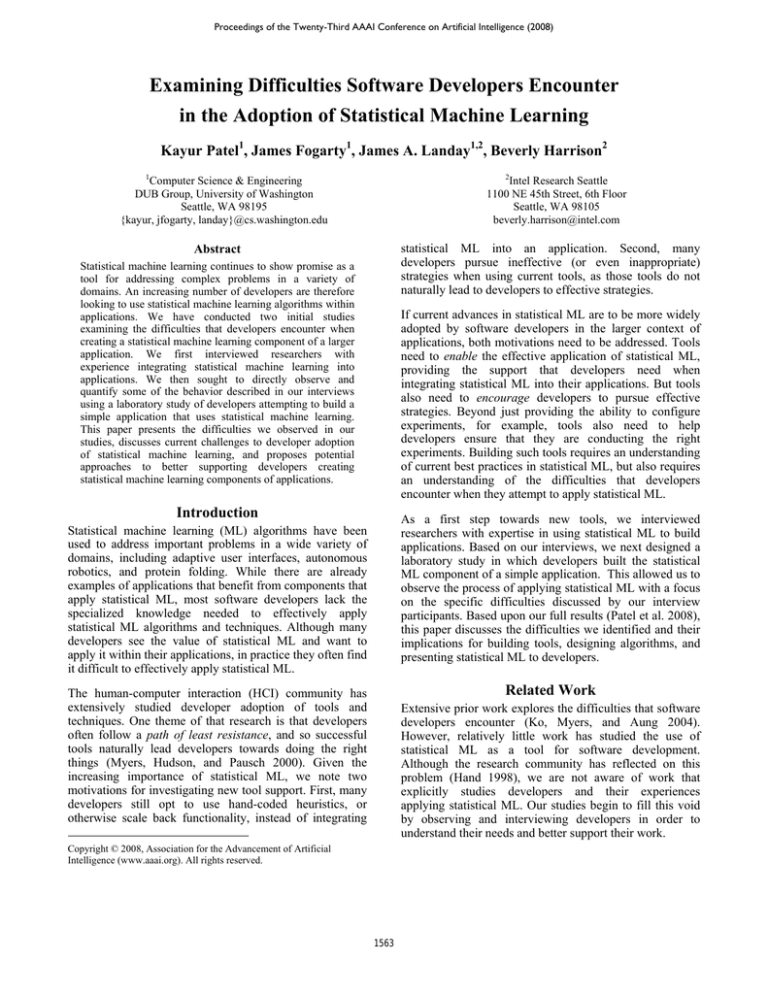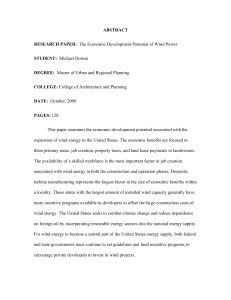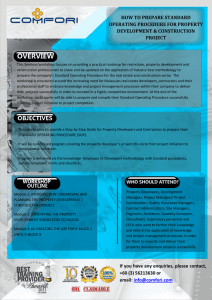
Proceedings of the Twenty-Third AAAI Conference on Artificial Intelligence (2008)
Examining Difficulties Software Developers Encounter
in the Adoption of Statistical Machine Learning
Kayur Patel1, James Fogarty1, James A. Landay1,2, Beverly Harrison2
1
2
Computer Science & Engineering
DUB Group, University of Washington
Seattle, WA 98195
{kayur, jfogarty, landay}@cs.washington.edu
Intel Research Seattle
1100 NE 45th Street, 6th Floor
Seattle, WA 98105
beverly.harrison@intel.com
statistical ML into an application. Second, many
developers pursue ineffective (or even inappropriate)
strategies when using current tools, as those tools do not
naturally lead to developers to effective strategies.
Abstract
Statistical machine learning continues to show promise as a
tool for addressing complex problems in a variety of
domains. An increasing number of developers are therefore
looking to use statistical machine learning algorithms within
applications. We have conducted two initial studies
examining the difficulties that developers encounter when
creating a statistical machine learning component of a larger
application. We first interviewed researchers with
experience integrating statistical machine learning into
applications. We then sought to directly observe and
quantify some of the behavior described in our interviews
using a laboratory study of developers attempting to build a
simple application that uses statistical machine learning.
This paper presents the difficulties we observed in our
studies, discusses current challenges to developer adoption
of statistical machine learning, and proposes potential
approaches to better supporting developers creating
statistical machine learning components of applications.
If current advances in statistical ML are to be more widely
adopted by software developers in the larger context of
applications, both motivations need to be addressed. Tools
need to enable the effective application of statistical ML,
providing the support that developers need when
integrating statistical ML into their applications. But tools
also need to encourage developers to pursue effective
strategies. Beyond just providing the ability to configure
experiments, for example, tools also need to help
developers ensure that they are conducting the right
experiments. Building such tools requires an understanding
of current best practices in statistical ML, but also requires
an understanding of the difficulties that developers
encounter when they attempt to apply statistical ML.
Introduction
As a first step towards new tools, we interviewed
researchers with expertise in using statistical ML to build
applications. Based on our interviews, we next designed a
laboratory study in which developers built the statistical
ML component of a simple application. This allowed us to
observe the process of applying statistical ML with a focus
on the specific difficulties discussed by our interview
participants. Based upon our full results (Patel et al. 2008),
this paper discusses the difficulties we identified and their
implications for building tools, designing algorithms, and
presenting statistical ML to developers.
Statistical machine learning (ML) algorithms have been
used to address important problems in a wide variety of
domains, including adaptive user interfaces, autonomous
robotics, and protein folding. While there are already
examples of applications that benefit from components that
apply statistical ML, most software developers lack the
specialized knowledge needed to effectively apply
statistical ML algorithms and techniques. Although many
developers see the value of statistical ML and want to
apply it within their applications, in practice they often find
it difficult to effectively apply statistical ML.
Related Work
The human-computer interaction (HCI) community has
extensively studied developer adoption of tools and
techniques. One theme of that research is that developers
often follow a path of least resistance, and so successful
tools naturally lead developers towards doing the right
things (Myers, Hudson, and Pausch 2000). Given the
increasing importance of statistical ML, we note two
motivations for investigating new tool support. First, many
developers still opt to use hand-coded heuristics, or
otherwise scale back functionality, instead of integrating
Extensive prior work explores the difficulties that software
developers encounter (Ko, Myers, and Aung 2004).
However, relatively little work has studied the use of
statistical ML as a tool for software development.
Although the research community has reflected on this
problem (Hand 1998), we are not aware of work that
explicitly studies developers and their experiences
applying statistical ML. Our studies begin to fill this void
by observing and interviewing developers in order to
understand their needs and better support their work.
Copyright © 2008, Association for the Advancement of Artificial
Intelligence (www.aaai.org). All rights reserved.
1563
Tool support for ML currently exists in two forms. General
tools, such as Weka (Witten and Frank 2005), provide an
extensive library of learning algorithm implementations.
Although such tools make it very easy to conduct an
experiment comparing the accuracy of different algorithms
on benchmark datasets, they provide relatively poor
support for the end-to-end development of a statistical ML
component in the larger context of software development.
Accessible tools, such as Crayons (Fails and Olsen 2003),
focus on making it easy to develop a complete system. But
this ease of use is attained by focusing on a particular
domain and then hiding some of the complexity of the
problem by limiting options available to a developer (such
as limiting the developer to a pre-determined algorithm or
limiting the developer to providing training data for a
fully-automated system). A developer has little or no
recourse if their problem does not conform to the
assumptions made by the tool, as flexibility has been
sacrificed for ease of use. This paper discusses general
obstacles to accessibility and provides insight into creating
new tools that are both general and accessible.
test data is transformed into featurized data and the trained
model is then applied. This flow of data is linear, as each
step is dependent upon the output of previous steps.
In contrast to such a linear data flow, effective
development is fundamentally iterative and exploratory.
Unfortunately, developers inexperienced in applying
statistical ML can confuse a linear data flow with a linear
process. Furthermore, the boundaries between existing
tools can create information gaps that impede exploration.
Developers can often spend an inordinate amount of time
on one aspect of their problem, most commonly algorithm
selection, while failing to identify errors and deficiencies
in other aspects of their problem. One interview participant
described a project where he and his collaborators spent
too much time on algorithm selection: “We basically tried
a whole bunch of Weka experimentation and different
algorithms … nothing worked, so we decided that …
maybe we should explore the feature space.” Other
interview participants found that they could move past an
apparent dead-end by collecting additional data or by
changing their problem definition. Based on these
interviews, it is clear the effective application of statistical
ML requires iteratively exploring all aspects of a system.
Studies
To understand the difficulties that developers encounter
when integrating statistical ML into software, we first
interviewed researchers experienced in applying statistical
ML in applications. We interviewed statistical ML experts
who have applied their expertise to HCI applications as
well as HCI experts who have looked to use statistical ML
to solve their hard problems. Based on results from our
interviews, we then conducted a second study where
participants built a simple application that used statistical
ML. Over the course of five hours, participants worked on
many aspects of a statistical ML system: they collected
handwriting data, wrote Java code to extract features, and
trained classifiers using Weka. We tested the performance
of the resulting systems on data the participants did not
have access to (2000 handwritten digits gathered from 20
people). A more detailed explanation of our studies can be
found in our original publication (Patel et al. 2008).
Iterative exploration is impeded by current tools that create
information gaps when they encapsulate only a portion of
the process of applying statistical ML. For example, Weka
and other general tools are focused on modeling algorithm
selection, but do not directly address feature development.
They instead assume input in a general tabular format, with
rows corresponding to instances and columns to features.
This assumption makes it difficult or impossible to link the
featurized data back to the raw data from which it was
computed. There is thus no straightforward way to
implement even simple debugging functionality, such as
showing a developer the raw data associated with
misclassified examples from an experiment. One of our
interview participants, a statistical ML expert, lent some
insight into the importance of debugging statistical ML
systems. He reported using Matlab for much of his
prototyping, stating “I think it’s important to work in an
interactive environment, [because] you can go back and
ask a data structure ‘what did you do?’” In contrast, tools
that divide the process of applying statistical ML can
prevent effective debugging of a system and can lead
developers to become overly focused on the subset of the
problem captured by the tool.
Results
Based on our interviews and laboratory study, we distilled
three related categories of difficulties: (1) difficulty
following an iterative and exploratory process, (2)
difficulty understanding the relationships between data and
models, and (3) difficulty evaluating the performance of
models in the context of an application. We summarize
these difficulties here; please refer to our full paper for a
more detailed analysis and discussion.
Another difficulty becomes evident over time. A developer
may consider many different strategies for addressing a
problem, but information about previous strategies is lost
as a developer moves on. In order to track their progress,
developers resort to brittle record-keeping. For example,
one participant in our lab study resorted to naming a file
“LogitBoostWith8to18EvenWindow-Iter=10.model.” Four
other participants kept handwritten paper notebooks
tracking their progress. Such approaches have at least two
Following an Iterative and Exploratory Process
For many statistical ML problems, data flows through a
system in a typical manner. Raw training data is collected
and manipulated into a form from which features can be
extracted. Features are then extracted, and statistical ML
algorithms model the featurized data. During testing, raw
1564
problems. First, it is often difficult to track everything that
has changed between successive tests. Second, if a bug is
found in feature generation or data collection, it becomes
unclear whether previously explored strategies need to be
revisited. Automatic tracking of exploration is currently
difficult in part because tools address only portions of the
process of applying statistical ML.
application is not captured solely by accuracy. Developers
instead have other additional concerns. For example, one
interview participant discussed privacy in his sensing
application, stating “this was the kind of tradeoff between
[more expressive features] and [privacy-sensitive
features].” Further concerns include classification speed,
training time, and how to incorporate the collection of
training labels into an application. Often these factors need
to be assessed within the context of the application itself,
but current tools do not allow developers to easily export
their entire data flow (i.e., from raw data to a model) for
interactive testing within the context of an application.
Understanding Data and Output
Our interviews show that developers new to using
statistical ML tend to treat algorithms as “black boxes.”
They often expect algorithms to be immediately effective,
and so they neither attempt to manipulate model
parameters nor seek to understand how the algorithms
work. The “black box” mindset prevents developers from
understanding and debugging a system, and it is reinforced
by opaque implementations of algorithms in current tools.
Several interview participants also recalled difficulties they
had experienced when developing statistical ML systems
that needed to be robust to input from different people. For
example, one participant complained “the cross-validation
would show … 85% to 90% accuracy… and then [when]
you would try it … it worked extremely well for some
people and not well for others.” Developers often assume
that data gathered from a group of people will generalize to
the entire population, and this may be true with a
sufficiently representative group. However, large corpora
are both hard to collect and expensive to process.
In the best case, a lack of understanding leads developers
to randomly experiment with different algorithms, data,
and features. In the worst case, a lack of understanding can
mislead developers. One interview participant spent
months training a classifier of forum posts, using an
existing featurized dataset provided by another researcher.
After getting the model to perform reasonably in
cross-validation experiments, he found the model failed to
generalize. Looking back at the raw data, he saw there had
been a large spam attack on the forum, and all of the spam
was of the same class in his training data. The classifier
mistakenly learned about features correlated to spam, a
mistake he may have detected earlier if his tools provided
better insight into the basis for each classification.
We explicitly examined this difficulty in our laboratory
study by providing participants with data collected from
four different people. Participants could have used this data
to conduct experiments probing how well their systems
performed when tested with people who had not provided
training data (perhaps using an experiment that held out
data from one person in each trial). Every participant
instead used simple random cross-validation. One even
explicitly commented that they probably should take
advantage of having data from different people, but that
they would instead use a random cross-validation because
it was easier to do in Weka. We also note that participants
significantly over-estimated the reliability of their models
(t(9) = 5.96, p < .001). In fact, high performance led some
of our participants to quit the task early when additional
time may have led to better results. While random
In our laboratory study, the participants most experienced
with statistical ML initially used simple algorithms to help
gain an understanding of their features and data. In one
case, a participant used decision trees to figure out which
features were being selected and to understand the
relationship between features and classifier output. Later in
the session, after debugging his features, he shifted to
using more complex and less interpretable algorithms. This
staged experimentation process helped the participant
make better informed decisions about his next step.
Current tools not only accommodate bad experimentation
practice, but seem to encourage it. Because the primary
feedback given by current tools is simple accuracy values,
developers can mechanically manipulate a tool until it
reports an acceptably high accuracy. Tools instead need to
encourage developer understanding of statistical ML
systems, so that developers can understand why their
systems behave as they do and how they might take a
principled approach to improving upon an existing system.
P1
P2
P3
P4
P5
P6
P7
P8
P9
P10
Evaluating Performance in Applications
Developers often find it difficult to evaluate the
performance of statistical ML systems within the context
of their application. While current tools provide extensive
support for measuring accuracy, the success of an
Accuracy
Estimated by
Participant
87.8%
98.0%
89.1%
95.6%
91.3%
90.4%
72.0%
26.5%
92.8%
93.4%
Accuracy
on 2000
Test Digits
84.7%
74.3%
78.3%
82.9%
84.7%
78.0%
56.9%
22.8%
78.8%
84.4%
Error in
Accuracy
Estimate
3.1%
22.7%
10.8%
12.7%
6.6%
12.4%
15.1%
3.7%
14.0%
9.0%
Figure 1: Comparing estimates of model accuracy computed by
participants to model performance on 2000 test digits.
Participants significantly over-estimated model accuracy.
1565
cross-validation is an important tool, tools encourage it
even when it may not be appropriate. Tools instead need to
help developers design better experiments.
Presenting Statistical ML
Interview participants noted that their goal is to “make a
system work,” but this is hard even when implementing an
approach that has already been shown to work. Developers
would benefit greatly from repositories containing
information about what combinations of algorithms,
features, and data work well together, as well as code they
can then use in implementing their systems. Tool support
could facilitate this by providing a common framework
within which researchers could disseminate state of the art
techniques to developers.
Implications
As statistical ML continues to grow in importance,
development tools need to enable and encourage effective
practices. We now briefly present implications for building
statistical ML tools, designing algorithms, and presenting
statistical ML to developers.
Statistical ML Tools
Developers would also benefit from additional help
devising and following good experimental procedures.
More could be done to clarify the strengths, weakness, and
pitfalls of different algorithms. For example, a repository
could present an algorithm, datasets on which it performs
well, datasets on which it performs poorly, and a
discussion of why it behaves the way it does.
The first step to building more effective tools is to remove
the gaps within current tool chains. Tools might be
integrated using lightweight metadata that preserves the
origin of data as it is transformed. Another approach would
be to create an integrated development environment that
captures the entire process of building a statistical ML
system. Tools need to support a developer’s constant
exploration of all aspects of a system, enabling the
interactive debugging that is critical to the effective
development of statistical ML systems. For example, a
developer should be able to identify a misclassified
instance in a confusion matrix and then trace back through
every detail of the classification of that instance.
Conclusion
As statistical ML continues to grow in importance, its
methods and tools need to be made more accessible to
software developers. This paper presents initial work in
this direction by studying the development of statistical
ML components of applications, by presenting three
difficulties faced by developers, and by describing three
solutions for making statistical ML more approachable.
As integration becomes tighter, many new features become
possible. A tool could log a developer’s experimentation
history: the data, features, and algorithms they explore. If
an error is detected that invalidates a series of experiments
(e.g., an error in feature computation code), experiments
could be automatically rerun in the background.
Automated systems could mine experimentation histories
to suggest new experiments. A path through a history tree
could represent the steps needed to go from raw data to a
final model, and the code for that path could be
automatically exported for use within an application.
Acknowledgements
We thank the many other people who contributed to this work.
This work was supported in part by a gift from Intel Research, by
an equipment donation from Intel’s Higher Education Program,
and by Kayur Patel’s NDSEG Fellowship.
References
Designing Algorithms
Fails, J.A. and Olsen, D.R. (2003). Interactive Machine Learning.
International Conference on Intelligent User Interfaces
(IUI 2003), 39-45.
To effectively use statistical ML, developers need to
understand how and why a system failed. They need to be
able to diagnose and debug errors. However, many
statistical ML algorithms are not designed to help
developers understand classifiers. Algorithms are instead
opaque and difficult to interpret. Even algorithms that lend
themselves to human interpretability are presented by tools
as “black-boxes” and treated as such by developers.
Hand, D.J. (1998). Data Mining: Statistics and More? The
American Statistician, 52(2), 112-118.
Ko, A.J., Myers, B.A., and Aung, H. (2004). Six Learning Barriers in
End-User Programming Systems. IEEE Symposium on Visual
Languages and Human-Centric Computing (VLHCC 2004), 199-206.
Myers, B.A., Hudson, S.E., & Pausch, R.F. (2000). Past, Present,
and Future of User Interface Software Tools. ACM Transactions
on Computer-Human Interaction (TOCHI), 7(1), 3-28.
Prior work has focused on human-interpretable ML for end
users, but the developer population has received relatively
little attention. Developers attempting to use statistical ML
are actively working with features and data in
fundamentally different ways than end users. For example,
finding relationships between features and erroneous
behavior might lead a developer to identify and fix a bug in
feature computation code. To promote the adoption of
statistical ML by developers, greater emphasis needs to be
placed on algorithm interpretability and interactivity.
Patel, K., Fogarty, J., Landay, J.A., & Harrison, B. (2008).
Investigating Statistical Machine Learning as a Tool for Software
Development. ACM Conference on Human Factors and
Computing (CHI 2008), 29-38.
Witten, I.H., & Frank, E. (2005). Data Mining: Practical
Machine Learning Tools and Techniques with Java
Implementations. San Francisco: Morgan Kaufmann.
1566




